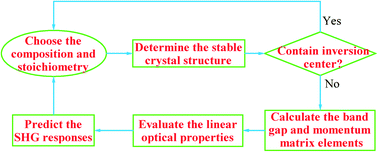Computational design of inorganic nonlinear optical crystals based on a genetic algorithm†
Abstract
Based on the results of density functional theory calculations, a theoretical method to design inorganic nonlinear optical (NLO) crystals for second harmonic generation (SHG) is presented. In this method, a specialized genetic algorithm (GA) is developed to search the stable structures of the inorganic crystal with known compositions and study the noncentrosymmetric stable structures and the second-order nonlinear optical properties by calculating the corresponding SHG coefficients. Unlike normal GA techniques, the main feature of the present method is that the coordination fashions of the building units are introduced to construct the structures of individuals during the GA procedure, which can obviously improve the efficiency and success rate of obtaining the stable structure of the inorganic crystals. As typical examples, two ternary compounds, AgGaS2 and LiAsSe2 crystals are considered, and besides the structures observed experimentally, the geometries and optical performance of other metastable (or more stable) phases have been explored. Our results clearly demonstrate that the present method can provide a feasible way to design and optimize new inorganic NLO crystals.


 Please wait while we load your content...
Please wait while we load your content...